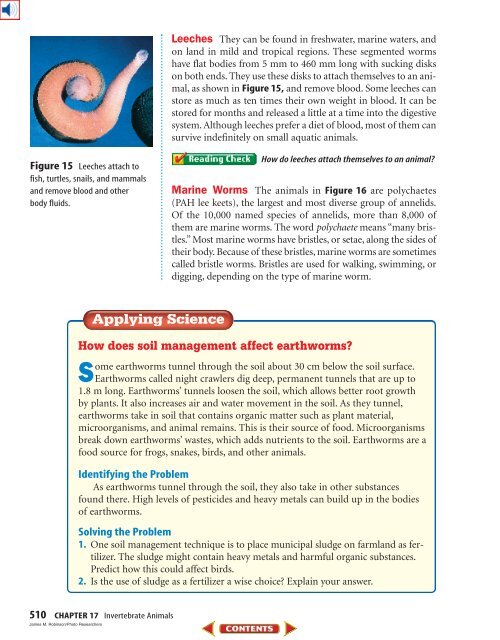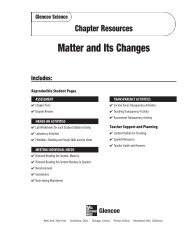Chapter 17: Invertebrate Animals
Chapter 17: Invertebrate Animals
Chapter 17: Invertebrate Animals
Create successful ePaper yourself
Turn your PDF publications into a flip-book with our unique Google optimized e-Paper software.
Leeches They can be found in freshwater, marine waters, and<br />
on land in mild and tropical regions. These segmented worms<br />
have flat bodies from 5 mm to 460 mm long with sucking disks<br />
on both ends. They use these disks to attach themselves to an animal,<br />
as shown in Figure 15, and remove blood. Some leeches can<br />
store as much as ten times their own weight in blood. It can be<br />
stored for months and released a little at a time into the digestive<br />
system. Although leeches prefer a diet of blood, most of them can<br />
survive indefinitely on small aquatic animals.<br />
Figure 15 Leeches attach to<br />
fish, turtles, snails, and mammals<br />
and remove blood and other<br />
body fluids.<br />
How do leeches attach themselves to an animal<br />
Marine Worms The animals in Figure 16 are polychaetes<br />
(PAH lee keets), the largest and most diverse group of annelids.<br />
Of the 10,000 named species of annelids, more than 8,000 of<br />
them are marine worms. The word polychaete means “many bristles.”<br />
Most marine worms have bristles, or setae, along the sides of<br />
their body. Because of these bristles, marine worms are sometimes<br />
called bristle worms. Bristles are used for walking, swimming, or<br />
digging, depending on the type of marine worm.<br />
How does soil management affect earthworms<br />
Some earthworms tunnel through the soil about 30 cm below the soil surface.<br />
Earthworms called night crawlers dig deep, permanent tunnels that are up to<br />
1.8 m long. Earthworms’ tunnels loosen the soil, which allows better root growth<br />
by plants. It also increases air and water movement in the soil. As they tunnel,<br />
earthworms take in soil that contains organic matter such as plant material,<br />
microorganisms, and animal remains. This is their source of food. Microorganisms<br />
break down earthworms’ wastes, which adds nutrients to the soil. Earthworms are a<br />
food source for frogs, snakes, birds, and other animals.<br />
Identifying the Problem<br />
As earthworms tunnel through the soil, they also take in other substances<br />
found there. High levels of pesticides and heavy metals can build up in the bodies<br />
of earthworms.<br />
Solving the Problem<br />
1. One soil management technique is to place municipal sludge on farmland as fertilizer.<br />
The sludge might contain heavy metals and harmful organic substances.<br />
Predict how this could affect birds.<br />
2. Is the use of sludge as a fertilizer a wise choice Explain your answer.<br />
510 CHAPTER <strong>17</strong> <strong>Invertebrate</strong> <strong>Animals</strong><br />
James M. Robinson/Photo Researchers














